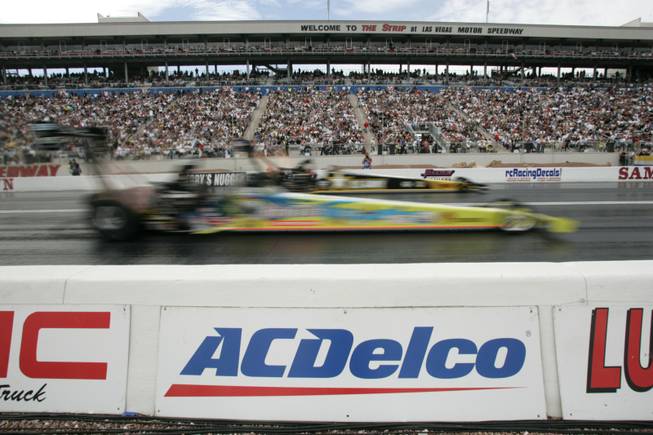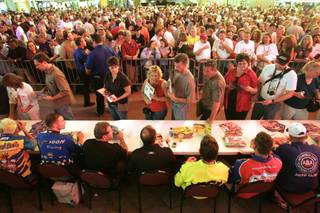
Tony Schumacher, far lane, and Joe Hartley race during Round 1 of the ACDelco Las Vegas Nationals on Sunday. Schumacher, who had clinched the series championship earlier in the week, won the race.
Monday, Nov. 3, 2008 | 2 a.m.
Beyond the Sun
Sun archives
With the advent of Television and then its little brothers, Cable and Satellite, it was inevitable that sports would become national in scope and the interest they generate.
But it could be argued that with the exception of the NFL, which has used the little red light on top of the camera to clothesline baseball as our National Pastime, many sports are better suited to — or at least better enjoyed in — the places they were created or that first embraced them.
Baseball is still big in the Northeast and in the Midwest, at least when the Cubs and Cardinals are winning.
Hockey is still revered in the Original Six cities of Montreal, Toronto, New York, Boston, Chicago and Detroit.
If you could see only one stock car race or or one college football game, you’d want it to be in the Southeast.
College basketball? If you’re Old School, the East Coast or Philadelphia. If you’re New School, anywhere on Tobacco Road.
The NBA is harder to pigeonhole but it seems to be more popular in the West these days — it’s the only stick and ball sport that can draw a crowd in Phoenix.
After walking around the staging area and the grandstand and, especially, the parking lot at the ACDelco Las Vegas NHRA Nationals at The Strip at Las Vegas Motor Speedway this weekend, it suddenly dawned on me why they don’t have a pro football team in Los Angeles: It’s because they’ve got surfing in the morning, beach volleyball in the afternoon and drag racing at night.
People from California love drag racing.
I can’t tell you how many Carquest Auto Parts Winternationals or Automobile Club of Southern California NHRA Finals or Fram Autolight Nationals, which is what they call the race in Sonoma, T-shirts I saw — or ones with the name of some speed shop from Bakersfield or Long Beach or Pomona. There also were a lot of West Coast Choppers T-shirts, which isn’t really drag racing, but close enough. In fact, if the Chargers ever move from San Diego to L.A., that’s what they should call themselves — the West Coast Choppers.
I saw a lot of women wearing halter tops that were more snug than the blower belt in John Force’s Funny Car. I didn’t check IDs, but you could tell they were from California, too. They had bushy-bushy blond hairdos, and I’ll just leave it at that.
Unlike with its NASCAR race, the Speedway does not keep statistics on where its drag racing ticket-buying customers come from. Jeff Motley, the LVMS publicity chief, said he was comfortable stating that most who come from out of state come from California. He suggested that on my way out, I could just check the license plates in the parking lot to confirm it.
I don’t know what the margin of error is for surveying three rows of cars parked off Wally Parks Drive. But I saw six Woodies and four El Caminos with surf boards strapped to the top, if that tells you anything. And three PT Cruisers with flames painted on their sides.
In one row, there were nine cars parked side by side that had California plates. Based on those three rows of cars, one in about every six persons you talked to could have been from California. Four had auto alarm systems that were way too sensitive. And one, belonging to a pickup truck with Idaho plates, probably is still sleeping under the grandstand, based on the number of empty beer cans that were scattered under and around his vehicle.
“I used to have this girlfriend who was Catholic,” a fan named Scott Johnson told me just before the Top Fuel guys woke up every desert tortoise from here to Mesquite with another series of eardrum-shattering, nitro-burning qualifying runs. “She asked what my religion was. I told her (drag) racing.”
Johnson owns a ceramic tile and hardwood floor business in his hometown of Bakersfield. He was smoking cigars under the main grandstand with his buddy, Galon Gordon, who races a nostalgic 1966 dragster at the Auto Club Famoso Raceway in Bakersfield. The two met at the track and became fast friends.
Johnson looks like the stereotypical drag racing fan. He’s got a scraggly beard and a tattoo. Gordon looks African-American. Actually, he is African-American. Even the black guys in Bakersfield like drag racing.
Gordon, 36, was a running back in high school. He also ran track. “The 100 meters — I’ve always run in a straight line,” he said.
Johnson, 38, inherited his passion for fast cars from his parents. That explains it more than anything, he said. It’s not so much that he grew up in California. He could operate a Texaco station in Timbuktu and he’d still like fast cars. It’s a chicken and an egg thing. Or at least a turbocharger and a hemi thing.
But where did his parents develop their passion for, as he put it, anything with wheels and an engine?
Maybe it’s because they grew up in California, too — at about the same time the NHRA was growing up.
Like most sports with wheels and an engine, drag racing began on the back roads of America after World World II. In California, guys with hot rods used to congregate at dry lake beds to see how fast they could go. That’s where Wally Parks, the man for whom the parking lot access at The Strip at LVMS is named, first was exposed to the guys with hot rods. Parks wound up organizing them into a group that became the National Hot Rod Association in 1951.
The NHRA held its first race on a tract of real estate adjacent to the Los Angeles Country Fairgrounds in Pomona. The Winternationals were born. When guys like John Milner and Bob Falfa weren’t tearing up the county roads on the outskirts of town in their deuce coupes and ’55 Chevies like in “American Graffiti,” they went to the Fairgrounds, where the cops didn’t mind.
Now in its fifth decade, the NHRA is the world’s largest motorsports sanctioning body. It has 80,000 members, 140 member tracks and more than 35,000 gearheads — er, licensed competitors. It has a schedule of 24 Nationals, ripping down the quarter-mile in places from Englishtown, N.J., where Bruce Springsteen’s pals raced their Chevrolets from the fire roads to the interstate; to Alligator Alley (or close enough) in Florida; to Brainerd, Minn., where, if you don’t watch out, police chief Marge Gunderson will getcha you betcha — especially if you’re driving in from Fargo.
But to me, California was, is and always will be the best place to watch cars race in a straight line, if for no other reason than halter-top season doesn’t last very long in Minnesota.


Join the Discussion:
Check this out for a full explanation of our conversion to the LiveFyre commenting system and instructions on how to sign up for an account.
Full comments policy